Impact of an E-Highway on the Required Battery Capacities and Charging Infrastructure for Cargo Transport with E-Trucks on the Basis of a Real Use Case
Abstract
:1. Introduction
Research Questions
- What battery capacities are required in the real case of a switch to all-electric trucks?
- To what extent can battery capacities be reduced by an e-highway in the case under consideration?
- What is the influence of the number of available charging stations and their capacity?
2. Materials and Methods
2.1. Basis of Data
2.2. Methodology for Answering the Research Questions
2.2.1. Creation of the Data Using Python and ORS
2.2.2. Scenarios
2.2.3. Calculations in MATLAB
3. Results
3.1. Highway Share, Number of (Charging) Locations, and Energy Consumption
3.2. Required Battery Capacities
3.3. Cost Reduction Potential
4. Discussion
Author Contributions
Funding
Institutional Review Board Statement
Informed Consent Statement
Data Availability Statement
Conflicts of Interest
Nomenclature
| Variable | Description | Unit |
|---|---|---|
| Electric energy consumption per route on highway routes | [kWh/km] | |
| Electric energy consumption per route on nonhighway routes | [kWh/km] | |
| Electric energy consumption per route | [kWh] | |
| Charging power at the charging locations | [kWh] | |
| Charging power on the highway with OLS per route | [kWh] | |
| Remaining energy in the battery | [kWh] | |
| Remaining energy in the battery when using an OLS | [kWh] | |
| Electric energy consumption on a highway section in a route segment | [kWh] | |
| Energy consumption on a nonhighway route in a route segment | [kWh] | |
| Distance of the highway section of the respective route | [km] | |
| Total distance of the respective route | [km] | |
| Average length of stay at the location | [s] | |
| Dwell time on highway section in a route segment | [s] | |
| Average speed between two locations | [km/h] | |
| Diesel consumption | [L] | |
| Maximum depth of discharge | [L] | |
| Loss of charge—vehicle | [L] | |
| Transmission loss—converter | [L] | |
| Loss of charge—charging station | [L] | |
| Loss of energy content due to arrangement to battery set | [%] | |
| Transmission loss—pantograph | [L] | |
| TtW—Diesel vehicle | [%] | |
| TtW—Electric vehicle | [%] | |
| Average energy consumption on highway routes | [kWh/km] | |
| Average electrical energy consumption of all trucks on highway routes | [kWh/km] | |
| Smallest required energy content of the battery | [kWh] | |
| Avg. smallest required energy content of the batteries | [kWh] | |
| Smallest required energy content of the battery when using an OLS | [kWh] | |
| Average smallest required energy content of the battery when using an OLS | [kWh] | |
| Average energy consumption of a truck on nonhighway routes | [kWh/km] | |
| Average electrical energy consumption of all trucks on nonhighway routes | [kWh/km] | |
| Energy content accumulator | [kWh/kg] | |
| Calorific value of diesel | [kWh/L] | |
| Battery cost | [EUR] | |
| Cost of the battery + current collector system when using OLS | [EUR] | |
| Average world market price of battery in 2030 | [EUR/kWh] | |
| Charging power at locations | [kW] | |
| Charging power—overhead line | [kW] | |
| Costs for the current collector system | [EUR] | |
| Distance on the highway | [km] | |
| Total distance travelled | [km] |
Appendix A
Appendix B
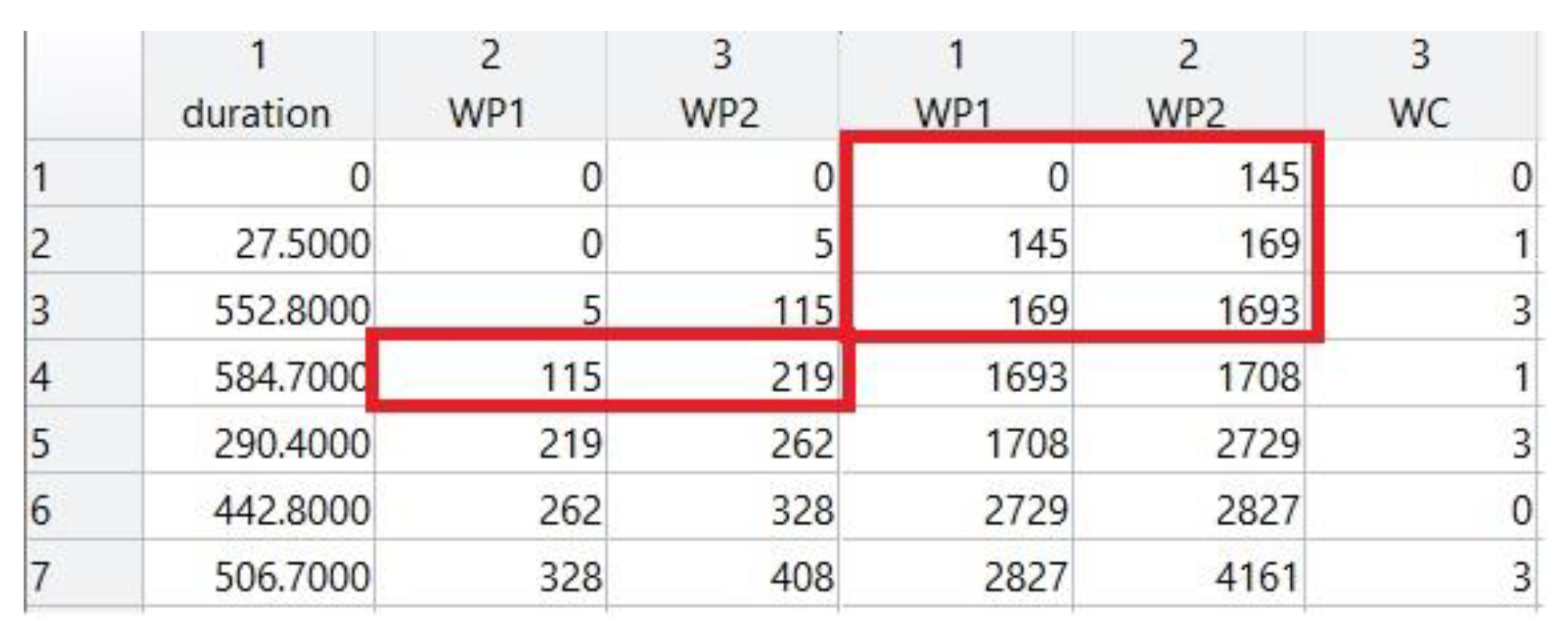

References
- European Commission. A Clean Planet for All. A European Strategic Long-Term Vision for a Prosperous, Modern, Competitive and Climate Neutral Economy. 2018. Available online: https://eur-lex.europa.eu/legal-content/EN/TXT/PDF/?uri=CELEX:52018DC0773&from=DE (accessed on 22 March 2022).
- Anderl, M.; Bartel, A.; Geiger, K.; Gugele, B.; Gössl, M.; Haider, S.; Heinfellner, H.; Heller, C.; Köther, T.; Krutzler, T.; et al. Klimaschutzbericht. 2020. Available online: https://www.umweltbundesamt.at/fileadmin/site/publikationen/rep0776.pdf (accessed on 22 March 2022).
- GmbH, S. Anteil an Treibhausgas-Emissionen in Österreich nach Sektor von 2013 bis 2018. Available online: https://de.statista.com/statistik/daten/studie/961611/umfrage/anteil-an-treibhausgas-emissionen-in-oesterreich-nach-sektor/ (accessed on 22 March 2022).
- Anderl, M.; Friedrich, A.; Gangl, M.; Haider, S.; Köther, T.; Kriech, M.; Lampert, C.; Mandl, N.; Matthews, B.; Pazdernik, K.; et al. Austria‘s National Inventory Report 2020. Umweltbundesamt GmbH. Available online: https://www.umweltbundesamt.at/fileadmin/site/publikationen/rep0724.pdf (accessed on 22 March 2022).
- Heinfellner, H. Sachstandsbericht Mobilität Und Mögliche Zielpfade Zur Erreichung Der Klimaziele 2050 Mit Dem Zwischenziel 2030. 2019. Available online: https://www.umweltbundesamt.at/studien-reports/publikationsdetail?pub_id=2268&cHash=3cc666e5b22063bb3a507fb26ba7afc6 (accessed on 22 March 2022).
- Statistik Austria. Kfz-Neuzulassungen Jänner bis Dezember 2021. 2022. Available online: https://www.statistik.at/wcm/idc/idcplg?IdcService=GET_PDF_FILE&RevisionSelectionMethod=LatestReleased&dDocName=125345 (accessed on 22 March 2022).
- Statistik Austria. Kfz-Neuzulassungen von Elektro-Kfz im 1. Halbjahr 2021. 2021. Available online: https://www.statistik.at/wcm/idc/idcplg?IdcService=GET_PDF_FILE&RevisionSelectionMethod=LatestReleased&dDocName=126389 (accessed on 22 March 2022).
- Kampker, A.; Vallée, D.; Schnettler, A. (Eds.) Elektromobilität: Grundlagen einer Zukunftstechnologie; Springer: Berlin/Heidelberg, Germany, 2018. [Google Scholar] [CrossRef]
- Gustavsson; Martin, G.H.; Hacker, F. Overview of ERS Concepts and Complementary Technologies. 2019. Available online: https://www.oeko.de/fileadmin/oekodoc/ERS-concepts-and-complementary-technologies.pdf (accessed on 22 March 2022).
- Grahn, M.; Azar, C.; Williander, M.; Anderson, J.E.; Mueller, S.A.; Wallington, T.J. Fuel and vehicle technology choices for passenger vehicles in achieving stringent CO2 targets: Connections between transportation and other energy sectors. Environ. Sci. Technol. 2009, 43, 3365–3371. [Google Scholar] [CrossRef]
- Kuramochi, T.; Höhne, N.; Schaeffer, M.; Cantzler, J.; Hare, B.; Deng, Y.; Blok, K. Ten key short-term sectoral benchmarks to limit warming to 1.5 °C. Clim. Policy 2018, 18, 287–305. [Google Scholar] [CrossRef]
- Taljegard, M.; Thorson, L.; Odenberger, M.; Johnsson, F. Large-scale implementation of electric road systems: Associated costs and the impact on CO2 emissions. Int. J. Sustain. Transp. 2020, 14, 606–619. [Google Scholar] [CrossRef]
- Börjesson, M.; Johansson, M.; Kågeson, P. The economics of electric roads. Transp. Part C Emerg. Technol. 2021, 125, 102990. [Google Scholar] [CrossRef]
- Eichlseder, H.; Klell, M. Wasserstoff in der Fahrzeugtechnik; Vieweg + Teubner Verlag: Wiesbaden, Germany, 2012. [Google Scholar] [CrossRef]
- Fiori, C.; Marzano, V. Modelling energy consumption of electric freight vehicles in urban pickup/delivery operations: Analysis and estimation on a real-world dataset. Transp. Res. Part Transp. Environ. Bd. 2018, 65, 658–673. [Google Scholar] [CrossRef]
- Batteries Europe ETIP. Strategic Research Agenda for Batteries 2020; European Commission: Brussels, Belgium, 2020. Available online: https://ec.europa.eu/energy/topics/technology-and-innovation/batteries-europe/news-articles-and-publications/sra_de (accessed on 24 August 2022).
- Röck, M.; Martin, R.; Hausberger, S. JEC Tank-to-Wheels Report v5: Heavy Duty Vehicles; Publications Office of the European Union: Luxemburg, 2020. Available online: https://publications.jrc.ec.europa.eu/repository/handle/JRC117564 (accessed on 24 August 2022).
- Energie-Control Austria. Leitfaden Netzanschluss. 2016. Available online: https://www.e-control.at/documents/1785851/1811582/e-control-leitfaden-netzanschluss-2016.pdf/fd727695-94d7-4a95-bcdf-1695dab0a16e?t=1468230491062 (accessed on 22 February 2022).
- Plötz, P. Infrastruktur Für Elektro-Lkw im Fernverkehr: Hochleistungsschnelllader und Oberleitung im Vergleich—ein Diskussionspapier; Fraunhofer ISI, Öko Institut, ifeu, Karlsruhe: Berlin/Heidelberg, Germany, 2021; Available online: https://www.oeko.de/publikationen/p-details (accessed on 22 February 2022).
- Hjelkrem, O.A.; Arnesen, P.; Bø, T.A.; Sondell, R.S. Estimation of tank-to-wheel efficiency functions based on type approval data. Appl. Energy 2020, 276, 115463. [Google Scholar] [CrossRef]
- BloombergNEF. Battery Pack Prices Fall to an Average of $132/kWh, But Rising Commodity Prices Start to Bite; BloombergNEF: New York, NY, USA, 2021; Available online: https://about.bnef.com/blog/battery-pack-prices-fall-to-an-average-of-132-kwh-but-rising-commodity-prices-start-to-bite/ (accessed on 23 April 2022).
- Wiener Börse, A.G. Wechselkurse EUR: Wiener Börse. Available online: https://www.wienerborse.at/marktdaten/wechselkurse/price-list-currencies/eur/ (accessed on 23 April 2022).
- Kühnel, S.; Hacker, F.; Görz, W. Oberleitungs-Lkw im Kontext Weiterer Antriebs- und Energieversorgungsoptionen für den Straßengüterfernverkehr; Öko-Institut e.V.: Berlin/Heidelberg, Germany, 2018; Available online: https://www.oeko.de/fileadmin/oekodoc/StratON-O-Lkw-Technologievergleich-2018.pdf (accessed on 23 April 2022).


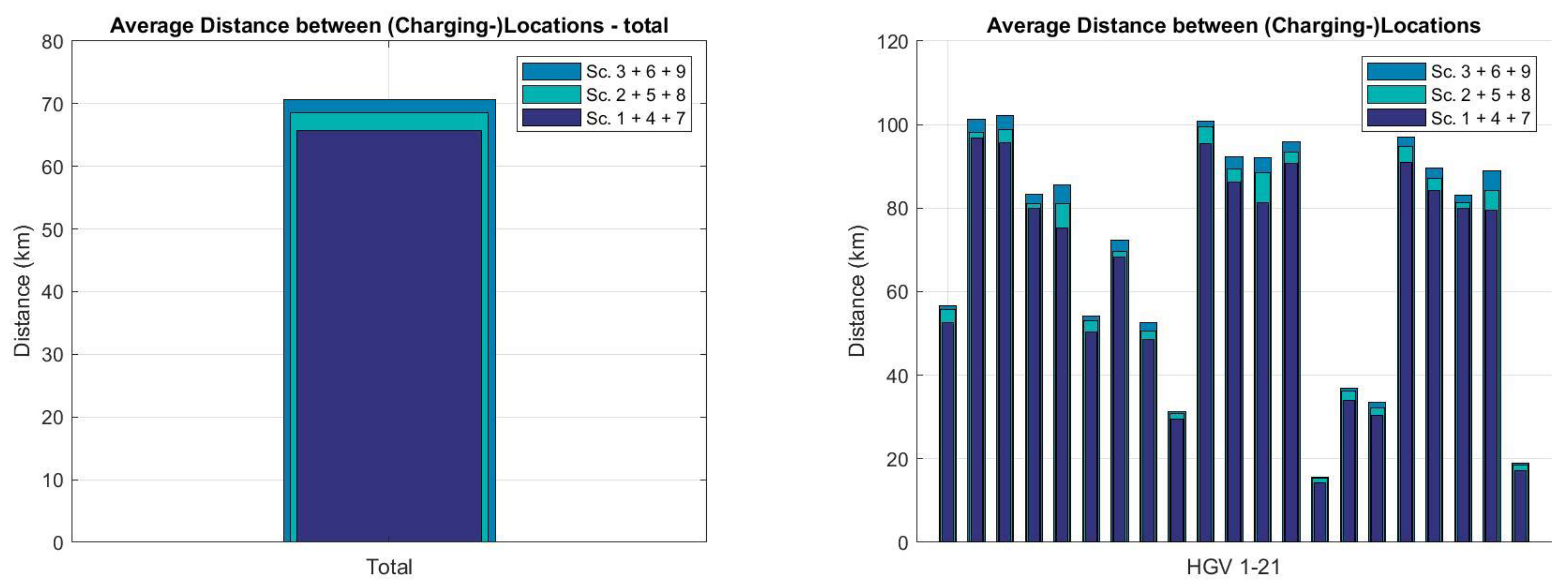
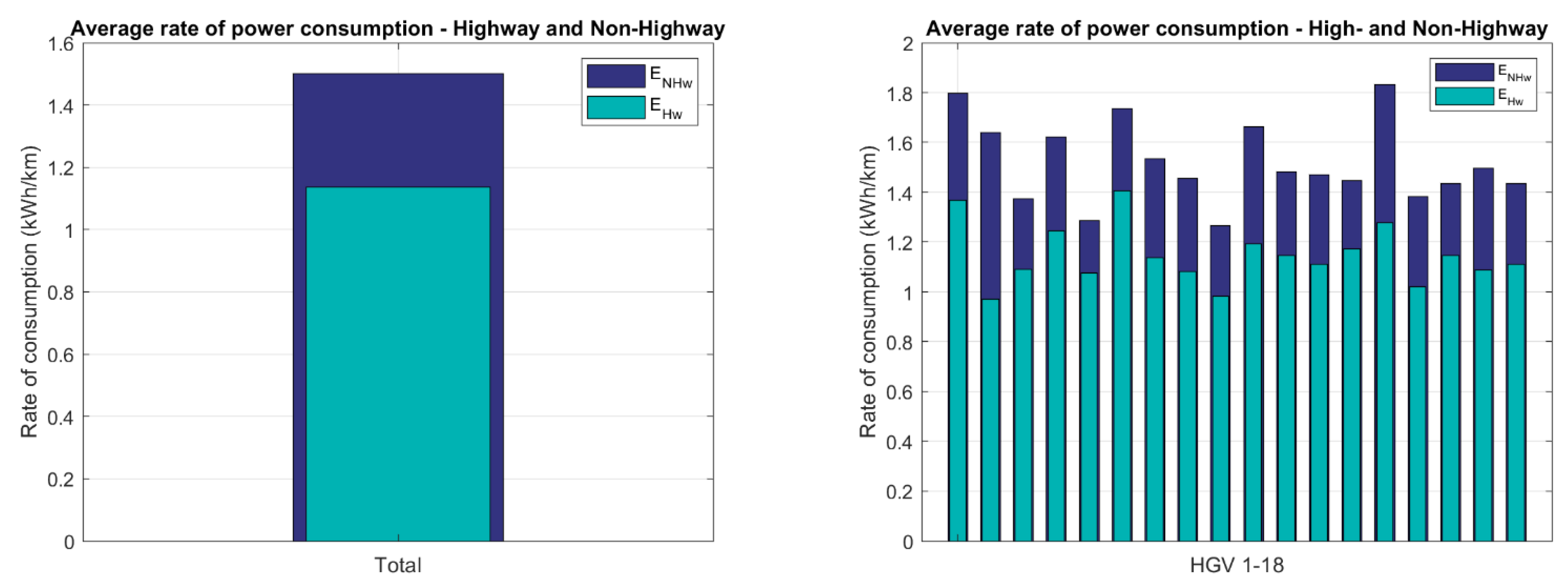



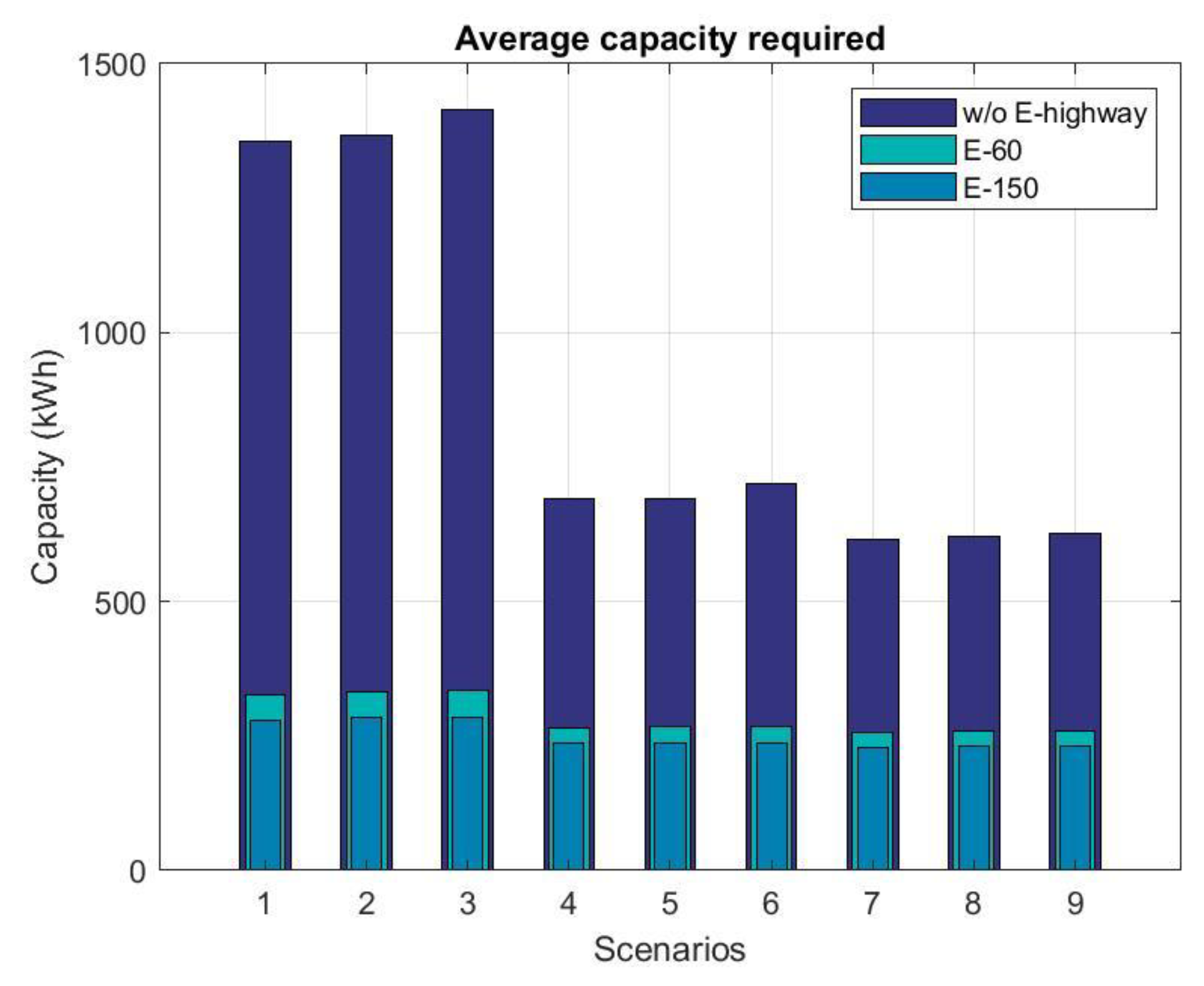
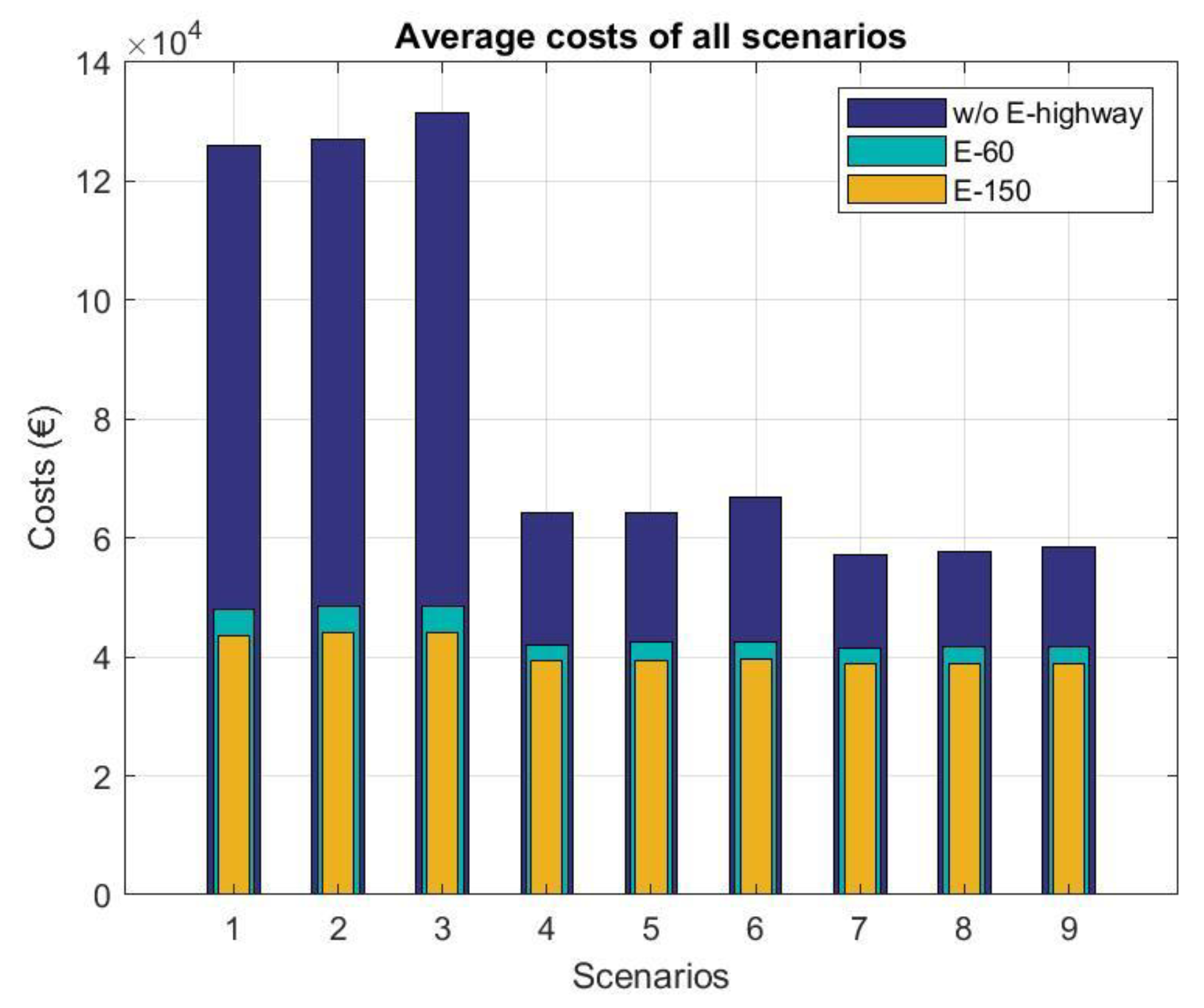

| Variable | Description | Value |
|---|---|---|
| TtW—Diesel vehicle | 30% [14] | |
| TtW—Electric vehicle | 80% [15] | |
| Calorific value diesel | 9.7 kWh/Liter | |
| Usage of nominal battery capacity | 80% [16] | |
| Charging power at locations | 50 kW/150 kW/350 kW | |
| Loss of charge—charging station | 7% [17] | |
| Loss of charge—vehicle | 7% [17] | |
| Charging power—overhead line | 60 kW/150 kW [18] | |
| Transmission loss pantograph | 2% [17] | |
| Transmission loss converter | 2% [17] |
| Number of Charging Locations | Charging Power—Charging Stations | Charging Power—OLS | |
|---|---|---|---|
| Scenario 1 | All | 50 kW | 60/150 kW |
| Scenario 2 | Limited (30%) | 50 kW | 60/150 kW |
| Scenario 3 | Limited (20%) | 50 kW | 60/150 kW |
| Scenario 4 | All | 150 kW | 60/150 kW |
| Scenario 5 | Limited (30%) | 150 kW | 60/150 kW |
| Scenario 6 | Limited (20%) | 150 kW | 60/150 kW |
| Scenario 7 | All | 350 kW | 60/150 kW |
| Scenario 8 | Limited (30%) | 350 kW | 60/150 kW |
| Scenario 9 | Limited (20%) | 350 kW | 60/150 kW |
Publisher’s Note: MDPI stays neutral with regard to jurisdictional claims in published maps and institutional affiliations. |
© 2022 by the authors. Licensee MDPI, Basel, Switzerland. This article is an open access article distributed under the terms and conditions of the Creative Commons Attribution (CC BY) license (https://creativecommons.org/licenses/by/4.0/).
Share and Cite
Netzer, L.; Wöss, D.; Märzinger, T.; Müller, W.; Pröll, T. Impact of an E-Highway on the Required Battery Capacities and Charging Infrastructure for Cargo Transport with E-Trucks on the Basis of a Real Use Case. Energies 2022, 15, 7102. https://doi.org/10.3390/en15197102
Netzer L, Wöss D, Märzinger T, Müller W, Pröll T. Impact of an E-Highway on the Required Battery Capacities and Charging Infrastructure for Cargo Transport with E-Trucks on the Basis of a Real Use Case. Energies. 2022; 15(19):7102. https://doi.org/10.3390/en15197102
Chicago/Turabian StyleNetzer, Lukas, David Wöss, Thomas Märzinger, Werner Müller, and Tobias Pröll. 2022. "Impact of an E-Highway on the Required Battery Capacities and Charging Infrastructure for Cargo Transport with E-Trucks on the Basis of a Real Use Case" Energies 15, no. 19: 7102. https://doi.org/10.3390/en15197102
APA StyleNetzer, L., Wöss, D., Märzinger, T., Müller, W., & Pröll, T. (2022). Impact of an E-Highway on the Required Battery Capacities and Charging Infrastructure for Cargo Transport with E-Trucks on the Basis of a Real Use Case. Energies, 15(19), 7102. https://doi.org/10.3390/en15197102






